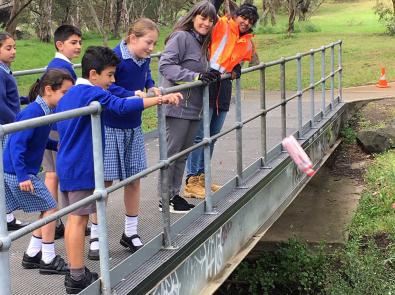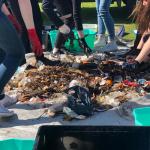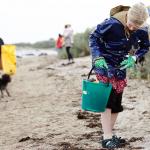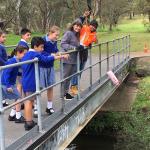Our city’s rivers and creeks receive stormwater that runs off roofs and roads in urban areas. This stormwater often contains litter carried from Melbourne’s streets. To trace the journey of litter, 100 bottles containing GPS trackers were released in creeks and rivers in Melbourne and their movements recorded.
Litter items may be trapped in stream-side vegetation, collected by litter traps, or transported along the waterway eventually ending up in Port Phillip Bay. Litter is a direct financial cost to local and state governments, and therefore to the community. It is also harmful to our wildlife in both freshwater and marine environments. The Victorian Government is working to reduce litter to protect our waterways and Port Phillip Bay.
Bottles containing Global Positioning System (GPS) trackers have been released in various creeks and rivers by schools and community groups to simulate the movement of litter through the stormwater drainage system. In all, 100 GPS-tracked bottles in 20 locations across Melbourne’s catchments have mapped precisely how litter makes its way from our streets to our beaches.
This resource is designed for students in Years 7 to 10. The case study gives an overview of the litter trackers launch and journey. Adapt the activity for your year level.
Download the lesson plan
This lesson plan contains modules explicitly linked to the Victorian Curriculum.
Activities
Activity 1: GPS trackers
Students use digital technology to practice using GPS trackers.
Activity 2: Measuring time and distance
Students use a tape measure, then apps, to measure the distance of moving things in the school yard and online.
Activity 3: Plotting the journey
Students plot the journey of litter tracker bottles and find out how the urban water cycle impacts the movement of litter.
Activity 4: Investigation
Students investigate their local waterway and land use over time.
Activity 5: Call to action
Students research campaigns that highlight the importance of a national approach to litter awareness.
Victorian curriculum links
- VCSSU090: Science and technology contribute to finding solutions to a range of contemporary issues; these solutions may impact on other areas of society and involve ethical considerations
Science > Science understanding - VCSSU101: Water is an important resource that cycles through the environment
Science > Science understanding - VCSSU116: The values and needs of contemporary society can influence the focus of scientific research
Science > Science understanding - VCSSU128: Global systems, including the carbon cycle, rely on interactions involving the atmosphere, biosphere, hydrosphere and lithosphere
Science > Science understanding - VCGGC102: Collect and record relevant geographical data and information from useful primary and secondary sources, using ethical protocols
Geography > Geographical concepts and skills - VCGGK106: Ways that flows of water connect places as they move through the environment and the ways this affects places
Geography > Geographical knowledge - VCGGC129: Identify, analyse and explain significant interconnections within places and between places over time and at different scales, and evaluate the resulting changes and further consequences
Geography > Geographical concepts and skills - VCGGC130: Collect and record relevant geographical data and information, using ethical protocols, from reliable and useful primary and secondary sources
Geography > Geographical concepts and skills - VCGGK145: Environmental, economic and technological factors that influence environmental change and human responses to its management
Geography > Geographical knowledge - VCMNA257: Investigate, interpret and analyse graphs from real life data, including consideration of domain and range
Mathematics > Number and algebra - VCMNA285: Plot graphs of non-linear real life data with and without the use of digital technologies, and interpret and analyse these graphs
Mathematics > Number and algebra
Resources
Litter action
Find out how you can stop litter at the source.
The Litter Trackers: Reducing Littering by Education
Litter is the most visible pollutant in the environment. Did you know that most of the litter on our beaches comes from suburban streets, transported through stormwater drains?
Tracking litter from our ‘burbs to the bay
To discover how precisely rubbish makes its way from these suburban streets through stormwater drains and onto our popular beaches, Melbourne Water has partnered with RMIT University to carry out a ground-breaking project.



